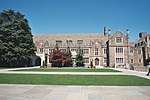Krzyzewskiville

Krzyzewskiville, or K-ville for short, is a phenomenon that occurs before major men's basketball games at Duke University. In simplest terms, it is the line for undergraduate students wishing to gain access to the designated tenting games. It is often mistakenly referred to as a ticket line. However, there are no student tickets; students are admitted from the line an hour and a half before each game. Krzyzewskiville is named for former head coach Mike Krzyzewski, often called "Coach K", the much loved coach who coached Duke from 1980 to 2022, and helped make Duke's basketball program one of the best in the nation. He was known to buy pizza for the K-ville residents from time to time and held open-forum "team meetings" with the Cameron Crazies before games against their arch-rival, the North Carolina Tar Heels. Graduate and professional students do not participate in Krzyzewskiville, as Duke's Graduate and Professional Student Council operates a separate weekend-long campout each September followed by a lottery for a small number of graduate and professional student season tickets.
Excerpt from the Wikipedia article Krzyzewskiville (License: CC BY-SA 3.0, Authors, Images).Krzyzewskiville
Kent Street, Durham
Geographical coordinates (GPS) Address Nearby Places Show on map
Geographical coordinates (GPS)
| Latitude | Longitude |
|---|---|
| N 35.99728 ° | E -78.94049 ° |
Address
Duke University
Kent Street
27708 Durham
North Carolina, United States
Open on Google Maps










